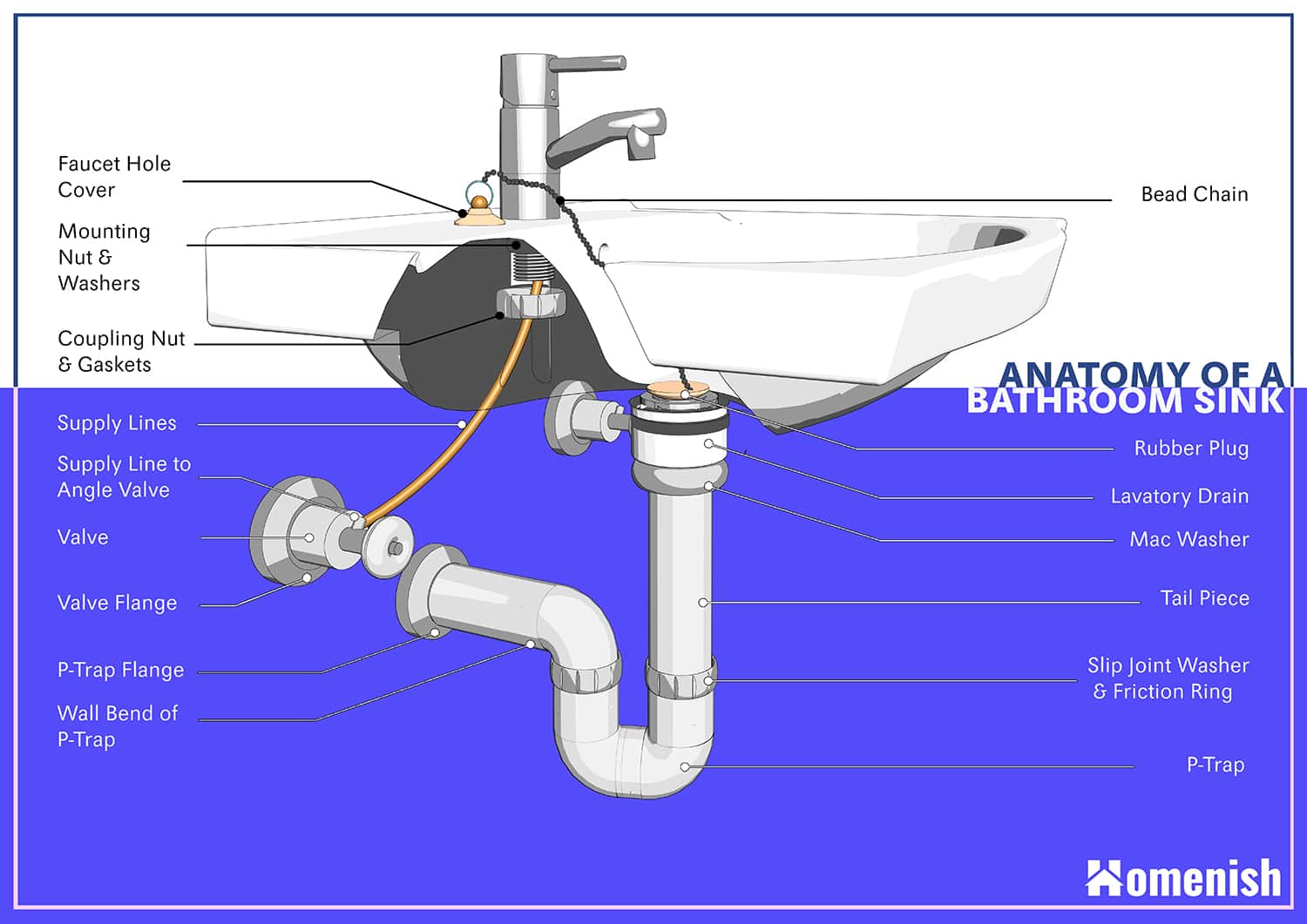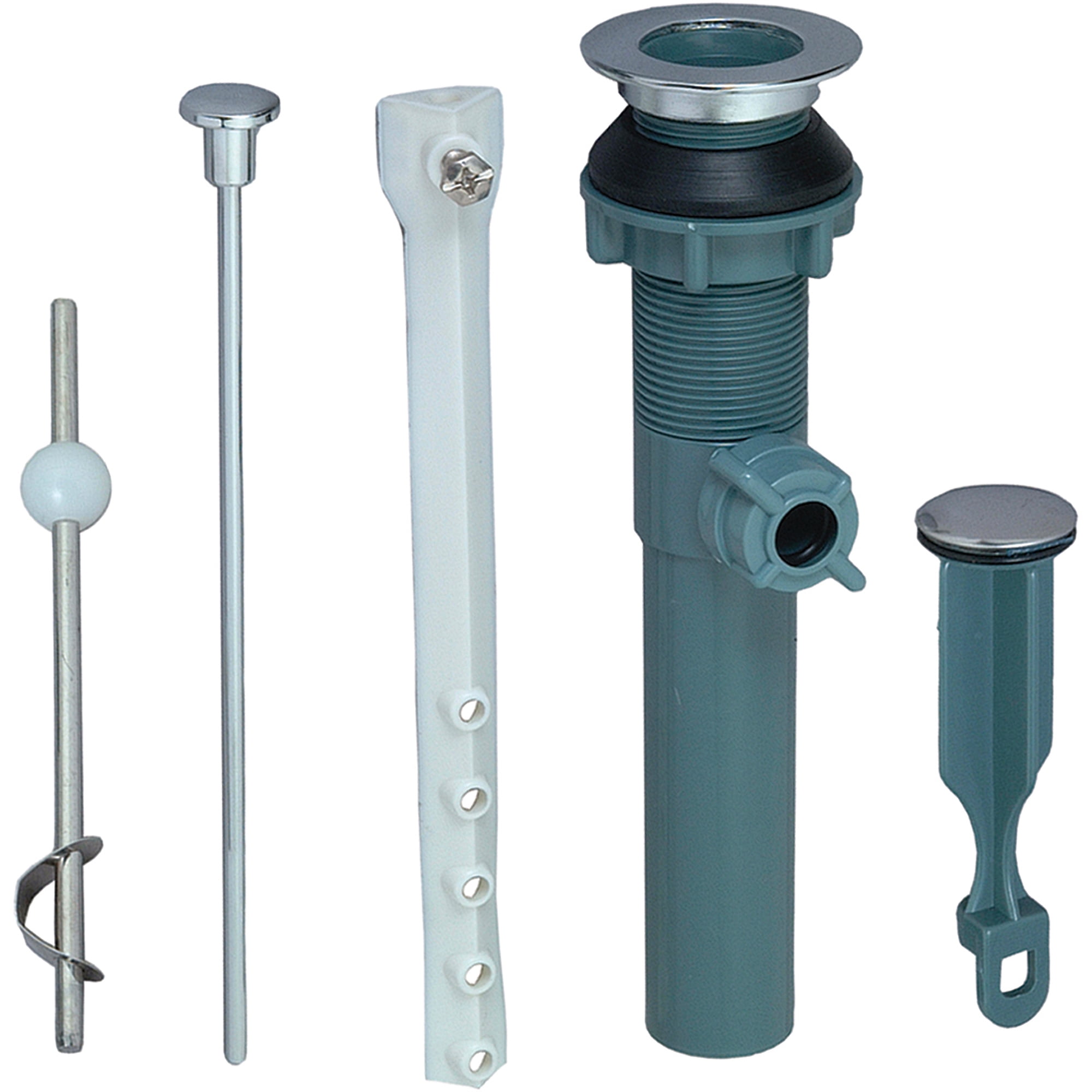Bathroom Vanity Drain Components

A bathroom vanity drain system is a vital part of any bathroom, effectively removing wastewater from the sink and preventing unpleasant odors from entering the room. This system comprises several components, each playing a crucial role in the smooth operation of the drain.
Components of a Bathroom Vanity Drain System
Each component of a bathroom vanity drain system serves a specific purpose, ensuring proper drainage and preventing clogs. Here’s a breakdown of the essential parts:
- Drain Body: The drain body is the main component of the system, connecting the sink to the plumbing system. It’s typically made of brass or stainless steel, providing durability and resistance to corrosion. The drain body features a threaded opening at the bottom to connect to the tailpiece and a threaded opening at the top to accommodate the strainer.
- Strainer: The strainer is the visible part of the drain, situated on the sink’s surface. It prevents debris like hair and soap from entering the drainpipe, minimizing the risk of clogs. Strainers are often made of brass, chrome, or stainless steel, matching the finish of the faucet and other bathroom fixtures.
- Tailpiece: The tailpiece is a short pipe connecting the drain body to the P-trap. It typically extends vertically from the drain body and allows for easy access to the drain for cleaning or repairs. Tailpieces are usually made of brass or PVC, depending on the specific application and budget.
- P-Trap: The P-trap is a crucial component that prevents sewer gases from entering the bathroom. It’s a U-shaped pipe filled with water that acts as a barrier, preventing the backflow of odors. P-traps are typically made of PVC or ABS plastic, offering durability and affordability.
- Overflow: The overflow is a small hole in the sink’s basin, situated above the drain. It acts as a safety feature, preventing water from overflowing the sink if the drain becomes blocked. The overflow is connected to the drainpipe through a small pipe, ensuring any excess water is directed to the drain.
Materials Used in Bathroom Vanity Drain Parts
The materials used in bathroom vanity drain parts significantly influence their durability, appearance, and cost. Here’s a table summarizing common materials used:
| Material | Properties | Advantages | Disadvantages |
|---|---|---|---|
| Brass | Durable, corrosion-resistant, malleable | High durability, long lifespan, elegant finish | More expensive than plastic or stainless steel |
| Chrome | Shiny, reflective, corrosion-resistant | Aesthetically pleasing, easy to clean | Susceptible to scratches and water spots |
| Plastic (PVC, ABS) | Lightweight, affordable, corrosion-resistant | Cost-effective, easy to install | Less durable than metal, may degrade over time |
| Stainless Steel | Durable, corrosion-resistant, hygienic | Resistant to rust and stains, easy to clean | More expensive than plastic, may scratch |
Finishes for Bathroom Vanity Drains
Bathroom vanity drains are available in a range of finishes, allowing homeowners to coordinate them with other bathroom fixtures and create a cohesive aesthetic. Common finishes include:
- Chrome: A classic and popular finish, chrome offers a shiny, reflective surface that adds a touch of elegance to any bathroom. It’s easy to clean and maintain, but susceptible to scratches and water spots.
- Nickel: Nickel offers a slightly warmer and less reflective finish than chrome, creating a more subtle look. It’s durable and resistant to corrosion, making it a popular choice for bathrooms.
- Brushed Nickel: Brushed nickel provides a matte finish with a subtle, brushed texture. It’s a popular choice for contemporary bathrooms, offering a modern and understated look.
- Oil-Rubbed Bronze: Oil-rubbed bronze offers a rich, dark brown finish with a warm, antique look. It’s a popular choice for traditional and rustic bathrooms, adding a touch of elegance and sophistication.
- Matte Black: Matte black offers a sleek, modern finish that complements a wide range of bathroom styles. It’s a popular choice for contemporary and minimalist bathrooms, adding a touch of sophistication and elegance.
Common Bathroom Vanity Drain Issues: Bathroom Vanity Drain Parts

Bathroom vanity drains, essential components of your bathroom, can experience a range of problems, from slow drainage to persistent leaks. These issues can disrupt your daily routine and potentially lead to more significant plumbing problems. Understanding the common causes and troubleshooting techniques for these issues is crucial for maintaining a functional and hygienic bathroom.
Slow Drainage
Slow drainage in a bathroom vanity drain is a common problem that can be caused by a variety of factors. The most frequent culprits include hair buildup, soap scum, mineral deposits, and clogs. Hair, a common culprit, easily accumulates in the drain, forming a barrier that restricts water flow. Soap scum, another frequent offender, can build up over time, creating a sticky film that traps debris and slows down drainage. Mineral deposits, often found in areas with hard water, can accumulate in the drainpipe, narrowing the passage and hindering water flow.
Leaks
Leaks in bathroom vanity drains can occur due to a variety of factors, including loose or damaged drain parts, worn-out seals, and cracked pipes. Loose or damaged drain parts, such as the drain stopper or the drain tailpiece, can allow water to leak through the connection points. Worn-out seals, often made of rubber or plastic, can lose their ability to create a tight seal, leading to leaks. Cracked pipes, caused by age, pressure fluctuations, or damage, can also lead to leaks.
Clogs
Clogs in bathroom vanity drains are often caused by a buildup of hair, soap scum, and other debris. Hair, as mentioned earlier, is a major contributor to clogs, as it easily traps other debris and forms a dense mass that obstructs water flow. Soap scum, with its sticky nature, can also contribute to clogs by binding hair and other debris together. Other items, such as toothpaste, cotton swabs, and even small toys, can also find their way into the drain and cause clogs.
Odors, Bathroom vanity drain parts
Unpleasant odors emanating from a bathroom vanity drain can be a sign of a variety of issues. Bacteria and mold, thriving in damp environments, can produce foul smells. Clogs, trapping food particles and other debris, can also create a breeding ground for bacteria, leading to unpleasant odors. Sewer gas, if there is a leak or a faulty trap, can also infiltrate the bathroom through the drain, causing a foul odor.
Troubleshooting and Resolving Bathroom Vanity Drain Issues
| Issue | Possible Causes | Troubleshooting Steps | Resolution |
|---|---|---|---|
| Slow Drainage | Hair buildup, soap scum, mineral deposits, clogs |
|
|
| Leaks | Loose or damaged drain parts, worn-out seals, cracked pipes |
|
|
| Clogs | Hair buildup, soap scum, other debris |
|
|
| Odors | Bacteria, mold, clogs, sewer gas |
|
|
Choosing the Right Bathroom Vanity Drain

Selecting the right bathroom vanity drain is crucial for ensuring proper water flow and maintaining the aesthetics of your bathroom. It is an often overlooked component, but a well-chosen drain can make a significant difference in the overall functionality and appearance of your vanity.
Types of Bathroom Vanity Drains
Bathroom vanity drains come in various styles, each with its unique advantages and drawbacks. Here are some of the most common types:
- Pop-up Drains: These are the most traditional and widely used type of drain. They feature a lever or knob that is pushed up to open the drain and pushed down to close it. Pop-up drains are typically inexpensive and easy to install.
- Push-Button Drains: Push-button drains are operated by a push-button mechanism that opens and closes the drain. They are often preferred for their sleek and modern appearance, but can be more expensive than pop-up drains.
- Basket Strainers: Basket strainers are designed to catch hair and debris before they can clog the drain. They are usually made of metal or plastic and are easily removable for cleaning. Basket strainers can be used with pop-up or push-button drains.
Factors to Consider When Choosing a Bathroom Vanity Drain
Several factors should be considered when selecting a bathroom vanity drain, ensuring compatibility and functionality:
- Sink Size and Style: The size and style of your sink will determine the appropriate size and style of the drain. For example, a large, rectangular sink may require a larger drain than a small, round sink.
- Drainpipe Type: The type of drainpipe you have will also affect your drain choice. Most bathroom vanity drains are designed for standard 1.5-inch drainpipes, but some may be compatible with other sizes.
- Desired Finish: Bathroom vanity drains are available in a variety of finishes, such as chrome, nickel, brass, and oil-rubbed bronze. Choose a finish that complements the other fixtures in your bathroom.
- Budget: Bathroom vanity drains range in price from a few dollars to several hundred dollars. Consider your budget when making your selection.
Popular Bathroom Vanity Drain Brands
Here is a table showcasing some popular bathroom vanity drain brands and their features:
| Brand | Features |
|---|---|
| Kohler | Known for their high quality and durability. Offer a wide range of styles and finishes. |
| Moen | Offer a wide selection of stylish and functional drains. Many models feature innovative features like leak detection. |
| Delta | Known for their innovative designs and high-performance features. Offer a variety of finishes and styles. |
| Grohe | Offer a wide range of high-end bathroom vanity drains. Known for their sleek and modern designs. |
